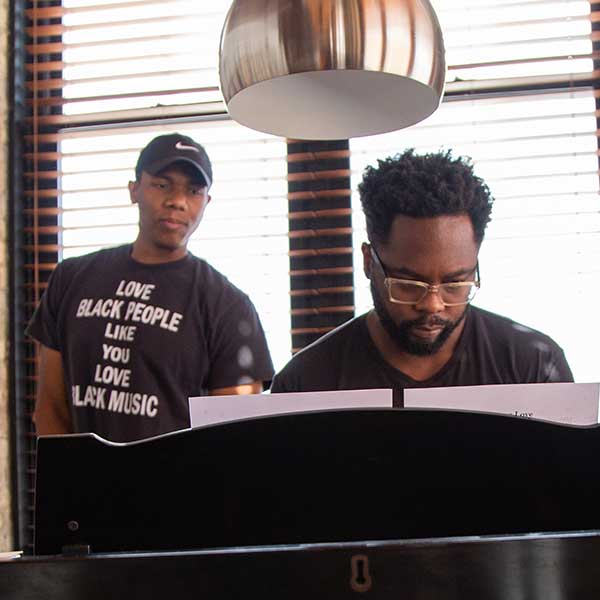January 31, 2023
A vision of hope
Among the most visible of Lyric's community engagement activities surrounding The Factotum is a series of colorful murals appearing around Chicago. Lyric commissioned Chicago artist Barrett Keithley to create the works, inspired by the themes of the opera.
The first mural, located at 5131 W. Madison Street in the Austin neighborhood on the city's West Side, is adjacent to a barbershop and a barbering school. A second mural is at 443 E. 79th Street in the Chatham neighborhood near a South Side barbershop, and a third mural can be found at 321 N. Cicero Avenue in the South Austin area.
We spoke with the artist just as he was completing the project — battling freezing temperatures and high winds to deliver colorful visions of Black joy and community hope.
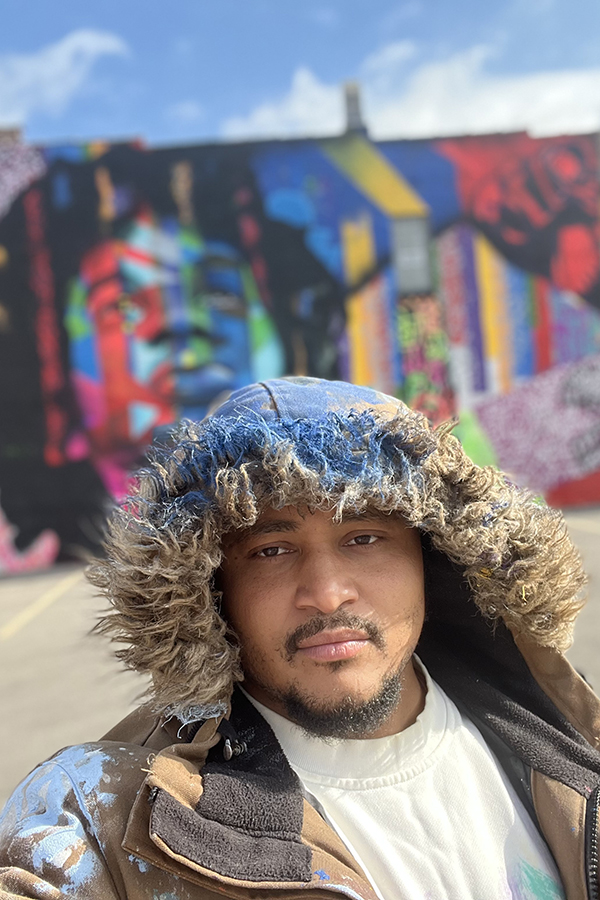
Chicago artist Barrett Keithley in front of the first of three murals inspired by The Factotum.
Do these works have titles?
I very rarely title a piece, and that's because of how I view artwork in the process of painting. That's when it's mine. That's when it's my sole responsibility. That's when it's up to me. I feel like when you name something or title something, you kind of place ownership over it. When I'm creating work, no one can come there, take it, or buy it because it's not finished. When it's done, then I feel like it's up to the audience to kind of allow their minds to go back into that childlike place of imagining what they are looking at and placing it in the framework of how they view the world, as opposed to, Here's the framework. Here's the title. Now you can look at it. I'd much rather the audience come up with something, because you end up getting a few different things.
The first one you completed, with the face of the boy — does he represent someone in the opera, or is it more abstract?
I would say a little bit of both. The face popped into my head when I started to read and learn more about the production — how it is about two brothers owning a barber shop on the South Side. We always have things that we need to get over, things challenging us. I wanted to portray a person who was looking up, looking hopeful despite all odds. The big Afro represents having abundance, and having confidence in your natural state. That's human. When we let ourselves flow, that's when we figure out how to get over whatever is challenging us.
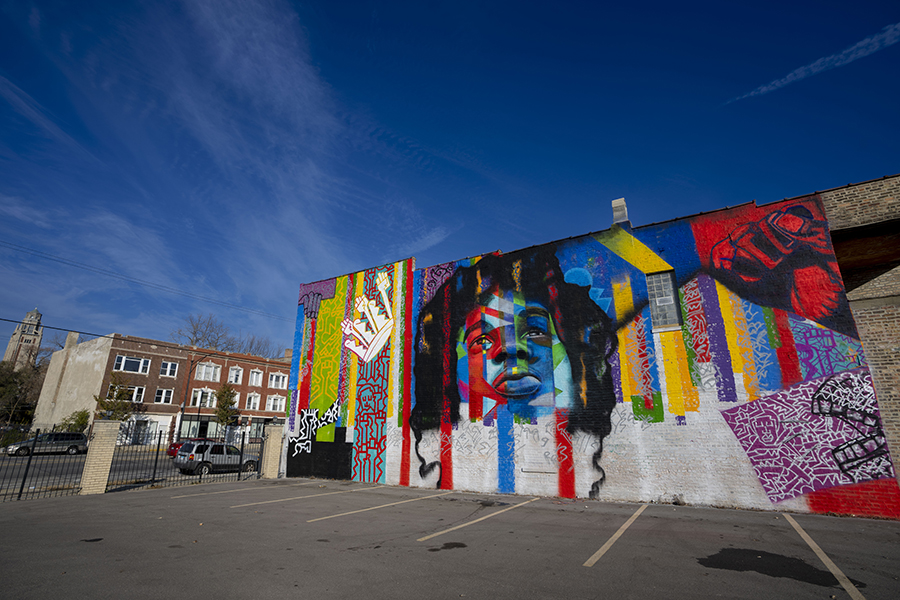
A work in progress: the first mural is located in Chicago's Austin neighborhood.
You had some challenges of your own.
I definitely had challenges with the weather. It was raining, it was cold. I had the whole gamut with that first piece. And the biggest challenge with the first piece was just the size of it. It's huge, maybe a little bit over 40 feet high and close to 70 feet wide. I did it mostly by myself.
And when that was done, winter was coming. What are your supplies?
The second mural and the third mural, those were the more challenging ones, because of the weather. I had to go through my paint supplies getting frozen and stuff like that. I'm using a spray paint and regular, outdoor acrylic paint. And elbow grease.
I bet.
It's a lot of physical work. The 79th street location is interesting because the only way for me to work on that piece was on a ladder. I think the ladder is about 30 or 40 feet itself. I have to carry it up to the roof and then place it on the wall and have to have a spotter at the bottom because the wind up there is pretty aggressive. It's already on top of a roof, so I'm 40 to 60 feet in the air.
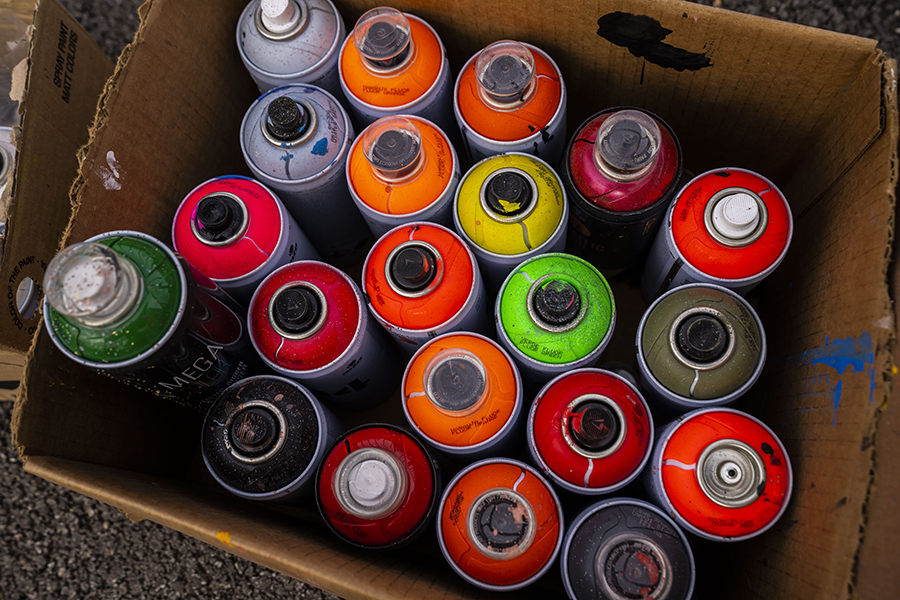
An artist's supplies: colorful cans of spray paint
How did you first become involved in this whole project?
It started at church camp. The summer I was 17, I decided to study theology at Emory University. My friends teased me: You're going to church camp instead of kicking with us the whole summer? I wanted to experience something different. I met a gentleman named Greg, from New York, and we became really good friends. It was a great experience for me because it was my first time being out of the South Side of Chicago. And Greg had a similar experience. And we connected that way, both of us being young black males out of the inner city. That's close to 20 years ago now.
You're talking about Gregory from Full Tilt Music Group.
He's the manager for DJ King Rico, one of The Factotum co-creators. And Greg told me that his client was coming into town and doing an opera and they were looking for some different approaches to marketing and things like that. He knew that I have created murals around the city of Chicago, and hosted lots of art shows and events — specifically in Black culture here. And eventually the conversation evolved, and DJ King Rico put me in contact with Lyric. I've been very excited, and so thankful. We've had so many obstacles that you just wouldn't think of until you start getting into the project.
Can you give us an example?
A lot of the black owned barber shops don't own their building, so it was hard to get approval to paint the murals. I think there's footage of me speaking to one of the owners where I had already started painting. They decided to retract their permission and I was trying to really convince them to let me finish. But things worked out in our favor — that's how I ended up finding that bigger wall, the first wall.
I've heard that you are a true Chicagoan.
I'm born and raised on the South Side of Chicago — Morgan Park, widely known as The Hundreds, because all the street numbers are in the hundreds. I lived as far south as you can go in Chicago, basically. That is its own, very unique world, and I've always said it's a great representation of the world itself, because on the east side you have one of the poorest areas, known for violence, and on the west side you have one of the richest neighborhoods in Chicago. Growing up I always had a choice because I had friends in both parts of the neighborhood. And at any point I could get into some trouble, but it depended on what kind of trouble I really wanted to get into.
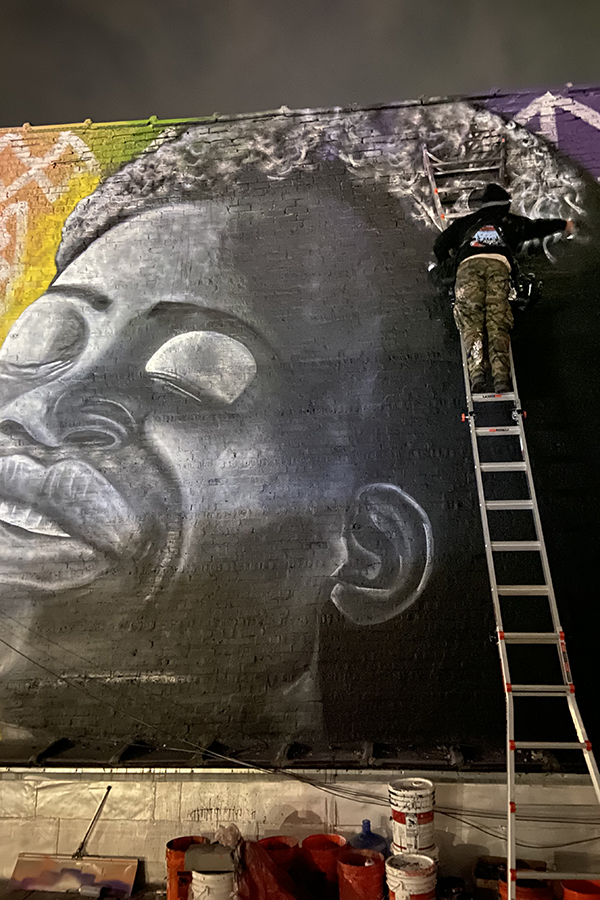
Artist Barrett Keithley — perched high on a ladder — works into the night on the second mural located in the Chatham neighborhood.
And you got into painting.
I always knew I wanted to be an entrepreneur, and I knew I wanted to be a resource to my community. I was working as a social worker for nearly ten years, working with young men and telling them to pursue their passion. And I decided to just quit that and practice what I preach. When I did that, I should have saved some money.
And as a full-time artist, you have still found a way to give back.
We created my nonprofit Paint the City in the wake of the George Floyd protests and the riots. And then during COVID, when everything was locked down and the businesses were boarded up, myself and my business partner, Missy Perkins, thought, This is obvious. We saw one big canvas. We saw blank boards and we were like, Oh, we should paint those. And that's what we did. We went around to different businesses, asked if we could paint the boards, and asked them to donate what they could for materials. And it became like a stamp: If you had a mural on your business, it wasn't getting bothered — it wasn't getting torn down or broken into or whatever.
Paint the City is a rather ambitious name.
Missy and I were getting ready to dispatch a bunch of artists to a bunch of different parts of the city. And I said, Oh, man, we're like... we're painting the block. And she said, No — we're painting the city! And I said, That's our name. We take on beautification projects, go to community gardens and clean those out and install murals and things like that. In January we went to my old high school to paint murals, to give it a fresh coat of paint, to give it a new teacher lounge, to give it new sports lockers. We do all of that. I'm doing it because I decided to stick to my guns and be an artist.
And now your work is even supporting opera.
When the city was all boarded up, it looked like one big "hood." And some parts of Chicago have been looking like that for decades. So you can imagine that when we started putting up artwork all around the city, it really lifted our spirits as a Chicago community. This project has been an opportunity for me to show that, when we're doing murals, especially in neighborhoods that are underserved, you get the chance to show that community their beauty. You awaken their brilliance.

